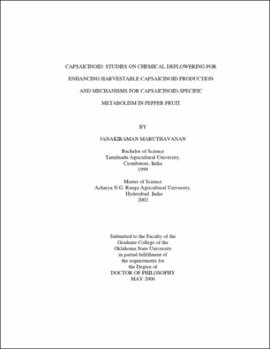| dc.contributor.advisor | Maness, Niels O. | |
| dc.contributor.author | Maruthavanan, Janakiraman | |
| dc.date.accessioned | 2013-11-26T08:30:06Z | |
| dc.date.available | 2013-11-26T08:30:06Z | |
| dc.date.issued | 2006-05 | |
| dc.identifier.uri | https://hdl.handle.net/11244/7129 | |
| dc.description.abstract | Scope and Method of Study: Ammonium thiosulfate (ATS) was applied as a spray to field grown pepper plants at various concentrations [0, 3, 6, 9 and 12 percent (w/v)] as a single application after the first, second or third flowering flushes, or as multiple applications after the first and second or after the first, second and third flowering flush. Pepper yields were assessed after a killing frost, and capsaicinoid content was evaluated by HPLC of N, N-dimethylformamide extracts. Pepper plants from greenhouse with known and varying pungency and capsaicin (CAP) : dihydrocapsaicin (DC) ratios were harvested at mature green, turning and red maturity stages, placental tissue was excised and capsaicinoids and lipid fractions were analyzed. Short branched chain fatty acid precursors for capsaicin (8-methyl-6-nonenoic acid; E) and for dihydrocapsaicin (8-methylnonanoic acid; A) were evaluated in bonded phase aminopropyl column eluates, in relation to capsaicinoid content. | |
| dc.description.abstract | Findings and Conclusions: Among 5 trials conducted on 'Plant 19' and 'Okala' at Bixby and Hydro, OK (2002 and 2003) higher concentration of ATS (6%, 9% and 12%) was more effective than control and 3% ATS treatments, in the removal of early set flowers and increasing later set fruit yield and capsaicinoid content for 'Plant 19' Hydro, 2003 (P 0.05) and 'Okala' Hydro, 2003 (P 0.1). E and A fatty acids were predominantly found in only two lipid fractions; free fatty acids and fatty acid sterol ester (FASE) fractions. E and A free fatty acid was higher at earlier stages of pepper fruit development (higher in green than orange than red fruits). The ratio of E to A free fatty acid precursors was always higher at all stages of fruit development. The FASE fraction was characterized by high performance thin layer chromatography (HPTLC) as a prominent spot coeluting with cholesterol/sterol ester standards and was devoid of free fatty acids. High performance liquid chromatography/atmospheric pressure chemical ionization-mass spectrometry (HPLC-APCI-MS) provided strong evidence that E and A was present in pepper placental extracts as FASE. | |
| dc.format | application/pdf | |
| dc.language | en_US | |
| dc.rights | Copyright is held by the author who has granted the Oklahoma State University Library the non-exclusive right to share this material in its institutional repository. Contact Digital Library Services at lib-dls@okstate.edu or 405-744-9161 for the permission policy on the use, reproduction or distribution of this material. | |
| dc.title | Capsaicinoid: Studies on chemical deflowering for enhancing harvestable capsaicinoid production and mechanisms for capsaicinoid-specific metabolism in pepper fruit | |
| dc.contributor.committeeMember | Motes, James E. | |
| dc.contributor.committeeMember | Dillwith, Jack W. | |
| dc.contributor.committeeMember | Martin, Bjorn | |
| osu.filename | Maruthavanan_okstate_0664D_1831 | |
| osu.accesstype | Open Access | |
| dc.type.genre | Dissertation | |
| dc.type.material | Text | |
| thesis.degree.discipline | Crop Science | |
| thesis.degree.grantor | Oklahoma State University | |
